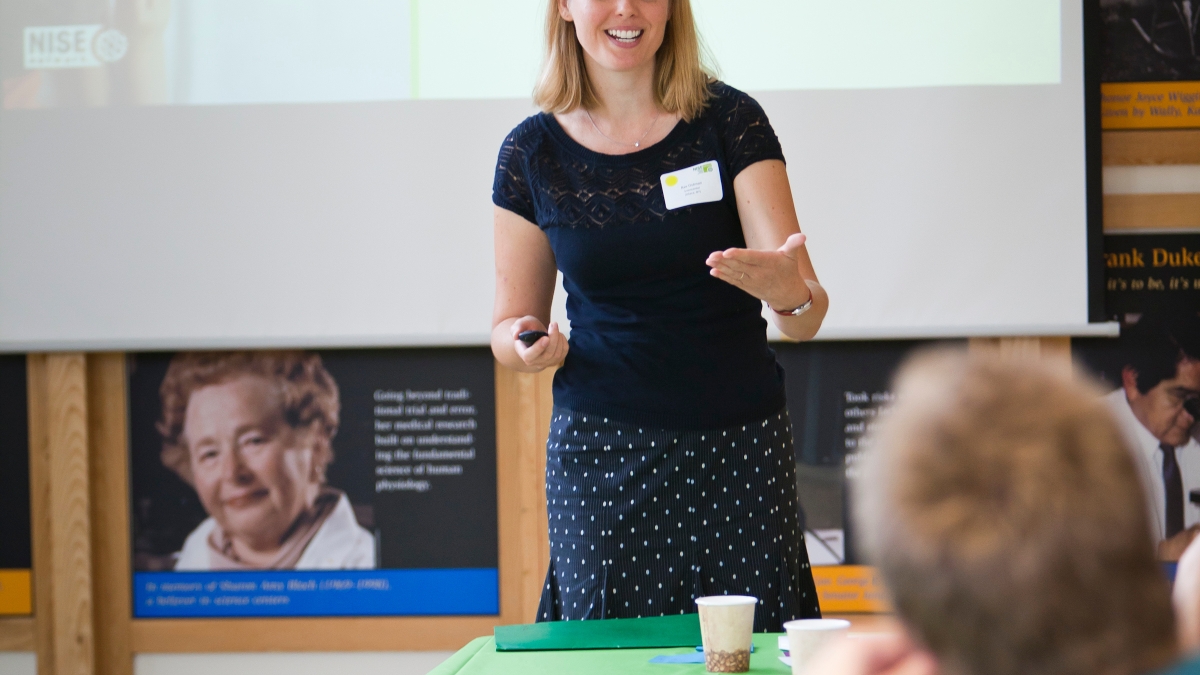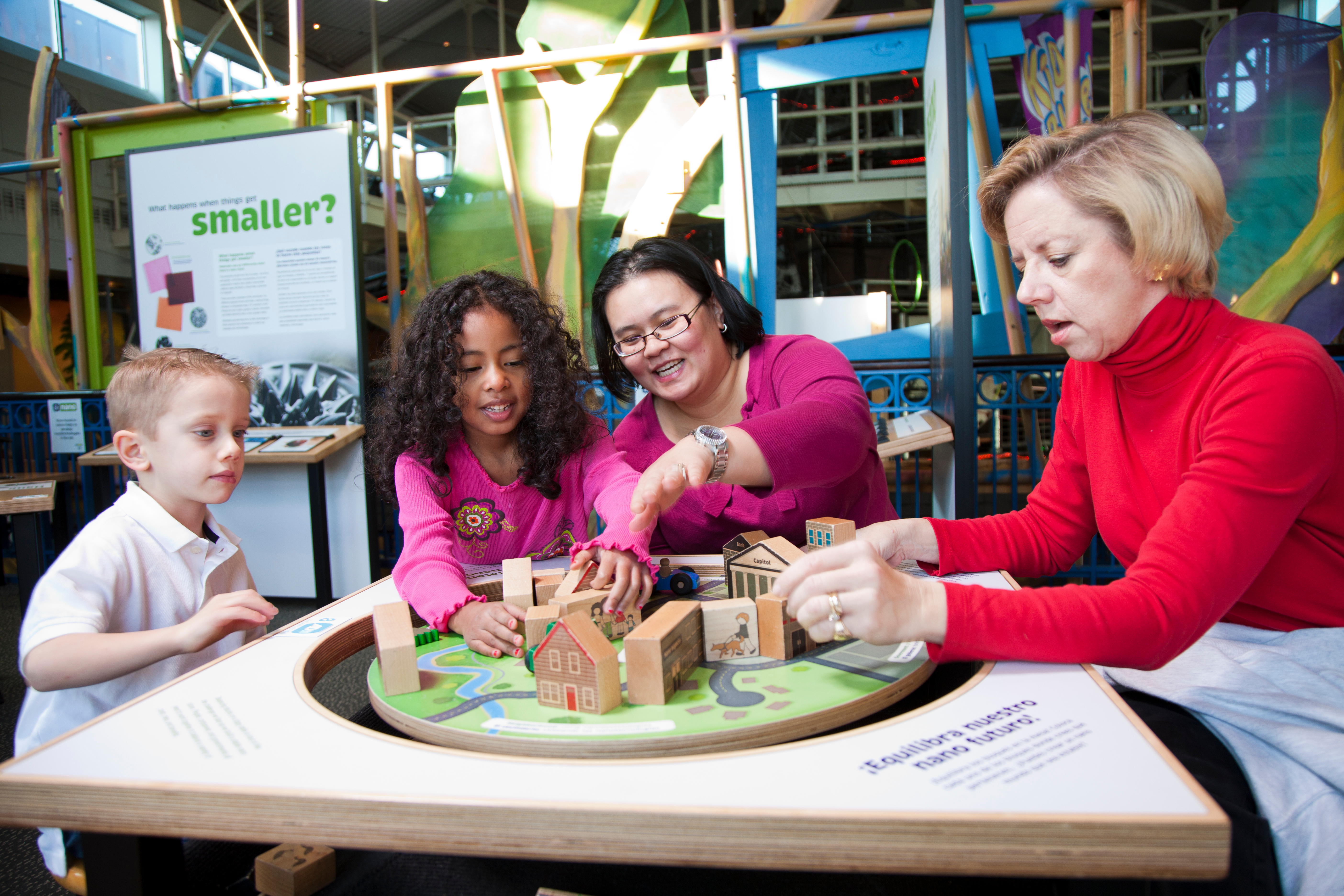ASU strengthens STEM education 'ecosystem' through museum initiatives

Rae Ostman presents at a workshop for museum educators on public engagement products. Ostman is director of special projects with the Science Museum of Minnesota and associate research professor with the Center for Engagement and Training in Science and Society, which is part of ASU’s new School for the Future of Innovation in Society. Photo courtesy of Gary Hodges/NISE Network
For many museums, their popularity and reputation ride on how many Renoirs or one-of-a-kind relics they have in their collections. Not so with science museums.
“Everything we do is about creating meaningful learning experiences for our audiences,” said Rae Ostman, director of special projects with the Science Museum of Minnesota and associate research professor with the Center for Engagement and Training in Science and Society (CENTSS), which is an affiliate of Arizona State University’s new School for the Future of Innovation in Society. “Science museums provide a place where people of all backgrounds can explore science at any point in their lives through hands-on, open-ended, social learning experiences.”
This impact and accessibility can play a critical role in the larger STEM education “ecosystem.”
“The ecosystem analogy emphasizes the work educators do to make connections between science and everyday life and create pathways for learners between cultural organizations and home, work, or school,” said Ostman. “Science museums, for example, can inspire a new interest in science, which can then be explored in more depth in school or at a library.”
This spring CENTSS will be offering a new museum internship for ASU students at the Arizona Science Center, which will allow students to develop a range of education and communication skills by participating in ongoing museum programming and innovative new projects. Interns can work in the science center’s new CREATE maker space or on special science events, such as the Arizona Science & Engineering Fair, the Arizona SciTech Festival, the Sustainability Solutions Festival and spring break camps.
In addition to widely applicable skills, interns will develop specialized knowledge about how to facilitate conversations with museum visitors about the impact of science and technology on their lives, now and in the future.
“The museum educator is no longer just a wizard of information but is also someone who can help visitors talk through what is important to them and grapple with how their values relate to different technological developments,” said Ira Bennett, co-director of CENTSS and associate director of education with the Center for Nanotechnology in Society at ASU.
One of CENTSS’ main goals is to identify best practices to engage broad public audiences in thinking about the social dimensions of science and technology. The center has received funding for a variety of projects that integrate science-in-society perspectives into large-scale public engagement projects. For example, Ostman is co-investigator for the Space and Earth Informal Science Education (SEISE) project, funded by NASA and led by Paul Martin at the Science Museum of Minnesota. In this role, she will oversee the development of the project’s public education efforts, including four hands-on activity toolkits (distributed annually to 250 museums) and a small-footprint exhibition (distributed to 50 museums). SEISE is one of 27 projects funded through a $42 million NASA initiative to improve public scientific literacy and the efficacy of STEM education for learners of all ages.
“With this group of projects, NASA will provide opportunities for authentic STEM engagement that use the Science Mission Directorates’ unique assets, such as real data sets, imagery, and subject matter experts,” said Ostman. “The range of selected projects shows that NASA recognizes the importance of lifelong and informal learning that takes place outside of school and throughout people’s lives.” (Another selected project, the NASA Science Mission Directorate Exploration Connection, is being led by Lindy Elkins-Tanton, director of ASU’s School of Earth and Space Exploration.)
To fortify the larger science-learning ecosystem, SEISE will also offer professional development for informal science educators and help museums develop and sustain local partnerships with other educational institutions.
The toolkits and exhibitions are modeled after successful initiatives of the NSF-funded Nanoscale Informal Science Education Network (NISE Net), a national collaboration of researchers and informal science educators that reaches 11 million members of the public each year at more than 350 museums. Network research and evaluation demonstrates that these engagement formats offer an effective, efficient way to integrate science and society ideas into regular museum offerings, thereby reaching sizeable and diverse public audiences.
Visitors manipulate the "Balance Our Nano Future" exhibit at the Port Discovery museum for children in Baltimore, Maryland. Photo courtesy NISE Network
“They offer accessible demonstrations of phenomena or research that a museum professional can use to grab attention and spark conversations with people walking by,” said Bennett.
In addition to the NISE Net and SEISE projects, CENTSS is collaborating with units across ASU and museums throughout the United States on several other projects:
• As part of a project funded by the Environmental Protection Agency and led by Paul Westerhoff, professor in the ASU School of Sustainable Engineering and the Built Environment, CENTSS is developing museum programs to spark conversations between scientists and the public about the development, use and disposal of nano-enabled products.
• For the Walton Sustainability Solutions Initiatives, led by Patti Reiter, senior sustainability scientist in the ASU Julie Ann Wrigley Global Institute of Sustainability, CENTSS is collaborating with several science museums to develop hands-on activity kits, which will be distributed to 50 museums in 2015.
• Lee Gutkind, professor in the ASU School for the Future of Innovation in Society, is leading a project to develop creative nonfiction narratives to explore the relationship between science and religion; CENTSS will work with museums in the U.S. and Canada to share the resulting narratives through museum programming.
• Ostman is co-principal investigator for a transmedia museum project, led by Ed Finn, director of the ASU Center for Science and the Imagination, which explores science-in-society themes introduced in Mary Shelley’s novel “Frankenstein.” The NSF-funded project is developing an online digital museum, a toolkit of making activities for museums, and an array of activities that can be done online, at home or at other kinds of learning organizations such as libraries.
Ostman explains that these projects offer people the opportunity to develop a scientific worldview that understands science in its social context.
“Science is not an isolated endeavor that exists separately from society and culture,” said Ostman. “Museums can encourage people to explore science, to think about themselves as people who can do science, and to use science to approach problems and issues they care about.”
For more information or to apply to be a museum education intern, contact Jeannie Colton at Jeannie.Colton@asu.edu.
More Science and technology

ASU professor breeds new tomato variety, the 'Desert Dew'
In an era defined by climate volatility and resource scarcity, researchers are developing crops that can survive — and thrive —…

Science meets play: ASU researcher makes developmental science hands-on for families
On a Friday morning at the Edna Vihel Arts Center in Tempe, toddlers dip paint brushes into bright colors, decorating paper…

ASU water polo player defends the goal — and our data
Marie Rudasics is the last line of defense.Six players advance across the pool with a single objective in mind: making sure that…


